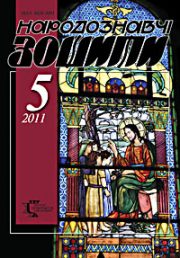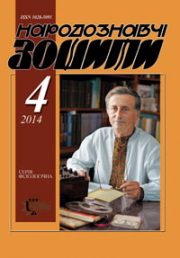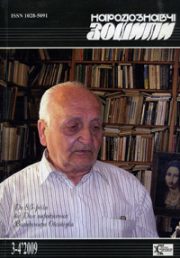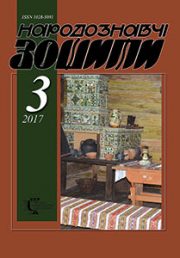The Ethnology Notebooks. 2024. № 4 (178), 936—944
UDK 069.61 (477.83-25) “1939/1941”
DOI https://doi.org/10.15407/nz2024.04.936
KHAVALKO Svitlana
- ORCID ID: https://orcid.org/0009-0006-5954-7467
- chief custodian,Lviv Historical Museum,
- 6, Rynok Square, 79008, Lviv, Ukraine,
- Contacts: e-mail: svitlo74@gmail.com
Abstract. After the arrival of Soviet power in Lviv in September 1939, the museum sphere was reorganized: out of 25 museums in the city only 6 remained. Ukrainian national museum institutions, private museum foundations, some collections of scientific institutions and religious congregations were liquidated: the museum of the Shevchenko Scientific Society (NTSh ). Based on the museum collections of the Historical Museum of the city of Lviv and the liquidated National Museum named after During the reign of King Jan III (1908-1939), the Lviv Historical Museum was created, where individual parts of the collections of the liquidated museums were transferred.
An archaeological collection, part of the phalerological collection, pottery, a collection of drawings and watercolors on the theme of the Talerhof concentration camp, and some items related to the events of the First World War were transferred from the Museum of the National Academy of Sciences to the Lviv Historical Museum. From the Military Historical Museum, photos of the Ukrainian Sich riflemen, chaplains of the UGA, important events, military operations, a set of photos representing the activities of Plast in the 1920s and 1930s, impressions of seals from 1918, military items, flags, drawings by Osyp Kurylas were transferred, Lev Gets, Mykhailo Havrylko, Leonid Perfetsky, paintings by P. Kholodny, Yu. Pankevich, I. Ivanets.
From the museum of the Stavropygius Institute, the Lviv Historical Museum now houses a part of the collection of portrait paintings of prominent figures of Lviv, a unique collection of 11 coffin portraits, about 270 pieces of valuable old prints of the 16th and 18th centuries and 150 handwritten Gospels of the 16th century.
1,270 units of various types of cold and firearms, details of military uniforms, elements of weapons and horse equipment were transferred from the liquidated Museum named after the Princes of Lubomyrsky to the Lviv Historical Museum. Part of the numismatic collection, orders and medals, seals, ebbs and seals, clocks, furniture, historical paintings, pictorial portraits, awards, silver memorabilia, about 220 portraits of the XVII—XX centuries.
Museum reorganization fundamentally influenced the development of the museum business and changed the model of interaction between the museum and society for decades to come. The liquidation of Ukrainian museums and the loss of numerous original monuments of national importance caused irreparable damage to Ukrainian historical heritage.
Keywords: museum, transfer, collection, monument, liquidation.
Received 10.07.2024
REFERENCES
- Ryabchykova, F. (2012). Museum building in the Western Ukrainian ethnic lands in 1939—1941. Volyn museum bulletin: Museums in research and preservation of cultural heritage monuments of the Western Ukrainian ethnic lands (Issue 4, pp. 12—18). Lutsk. Retrieved from: https://evnuir.vnu.edu.ua/bitstream/123456789/3886/1/vol_muz_visn2012.pdf [in Ukrainian].
- Man’kovs’ka, R. (2018). Deformation processes in museology: Western Ukrainian regions in 1939—1950. Local history, 2, 60—75. Retrieved from: http://resource.history.org.ua/publ/kraeznavstvo_2018_2_9 [in Ukrainian].
- Krutous, A. (1996). From the past of the Lviv Historical Museum. Naukovi zapysky (Issue 5, part 1, pp. 3—19). Lviv [in Ukrainian].
- Krutous, A. (2000). Pages from the past (1939—1990) of the Lviv Historical Museum. Naukovi zapysky (Issue 9, pp. 3—23). Lviv [in Ukrainian].
- Boyko, V. (1998). Monuments of the Ukrainian army: losses and legacy: to the 80th anniversary of the Ukrainian Galician Army. Naukovi zapysky (Vol. 7, pp. 117—128) [in Ukrainian].
- Filewych, N. (2007). Chronicle 1907—1947. Lviv Art Gallery. Lviv [in Ukrainian].
- (1995). Cultural life in Ukraine. Western lands. Documents and materials (Vol. 1, pp. 94—97). Kyiv [in Ukrainian].
- (1956). Soviet Lviv. 1939—1955. Documents and materials. Lviv [in Ukrainian].
- (1959). Cultural construction in the Ukrainian SSR (Vol. 1). Kyiv [in Ukrainian].
- Archive of the Lviv Historical Museum. Book of Orders of the Historical Museum for 1940—1941 [in Ukrainian].
- Sveshnikov, I. (2008). Memories of a museum worker. Sights of Ukraine, 2, II-XXXVII [in Ukrainian].
- (1945). Archive of the Lviv Historical Museum. General inventory book [in Ukrainian].
- Romanyuk, T. (2005). Scientific activity of Yaroslav Pasternak during the Second World War (1939—1944). Archaeological research of Lviv University. (Vol. 8, pp. 169—178). Retrieved from: https://clio.lnu.edu.ua/wp-content/uploads/2016/01/9-25.pdf [in Ukrainian].
- (2018). Lviv Historical Museum: album. Lviv [in Ukrainian].
- Zarubii, E. (2006). Silver neck ornaments of the princely era in the LIM collection. Naukovi zapysky (Vol. 11, pp. 90—103) [in Ukrainian].
- Zarubii, E. (2009). Gold and silver jewelry of the princely era in the collection of the Lviv Historical Museum. Kyiv [in Ukrainian].
- Zarubii, E. (2017). Bracelets made of non-ferrous metal of the «Kyivska Rus» fund group of the Lviv Historical Museum. Naukovi zapysky (Pp. 61—85) [in Ukrainian].
- Terskyi, S. (2021). Foundry forms and matrices of goldsmiths of the VIII—XIV centuries. in the funds of the Lviv Historical Museum. Naukovi zapysky (Vol. 19, pp. 21—36) [in Ukrainian].
- Zavitii, B. (2017). A treasure of bronze objects from Kolchev in the funds of the Lviv Historical Museum. Naukovi zapysky (Pp. 47—51) [in Ukrainian].
- Krukovskyi, O. (2017). New materials for the collection of Ukrainian phalerestics in the funds of LIM (based on the inventory books of the Museum of the National Academy of Sciences and the private collection of S. Haiduchka). Naukovi zapysky (Pp. 166—189) [in Ukrainian].
- Archive of the Lviv Historical Museum. Found 2591. Description 3. Case 170. Inventory book «Weapons» (Vol. 3: 1980—1981) [in Ukrainian].
- Archive of the Lviv Historical Museum. Found 2591. Description 3. Case 259. Inventory book «Weapons» (Vol. 6: 1982—1983) [in Ukrainian].
- Archive of the Lviv Historical Museum. Found 2591. Description 3. Case 137. Inventory book «Weapons» (Vol. 1: 1979) [in Ukrainian].
- Archive of the Lviv Historical Museum. Found 2591. Description 3. Case 304. Inventory book «Weapons» (Vol. 8: 1983—1984) [in Ukrainian].
- Bogdanov, S. (2021). Catalog «Portraits». Lviv Historical Museum. Lviv [in Ukrainian].
- Archive of the Lviv Historical Museum. Act of June 23, 1940 on the transfer of weapons to the Lviv Historical Museum from the former Lyubomirsky Museum [in Ukrainian].







